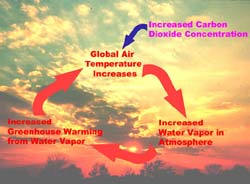
Physicists in New Zealand have shown that last November’s record-breaking solar explosion was much larger than previously estimated, thanks to innovative research using the upper atmosphere as a gigantic x-ray detector. Their findings have been accepted for 17 March publication in Geophysical Research Letters, published by the American Geophysical Union.
On 4 November 2003, the largest solar flare ever recorded exploded from the Sun’s surface, sending an intense burst of radiation

A NASA-funded study found some climate models might be overestimating the amount of water vapor entering the atmosphere as the Earth warms. Since water vapor is the most important heat-trapping greenhouse gas in our atmosphere, some climate forecasts may be overestimating future temperature increases.
In response to human emissions of greenhouse gases, like carbon dioxide, the Earth warms, more water evaporates from the ocean, and the amount of water vapor in the atmosphere increases. Since
A new study from the University of California shows, for the first time, that the deep-ocean circulation system of the north Atlantic, which controls ice-age cycles of cold and warm periods in the Northern Hemisphere, is integrally coupled to salinity levels in the Caribbean Sea.
This research reinforces concerns that global warming, by melting the glacial ice of Greenland, could quickly and profoundly change salinity and temperatures in the north Atlantic Ocean. One consequence might be mu
Large-scale, long-lasting droughts in the United States – such as the present one in the West — tend to be linked to warmer than normal sea surface temperatures in the North Atlantic Ocean, and not just cooling in the tropical Pacific, according to a USGS study published today in the Proceedings of the National Academy of Sciences.
The study statistically associates the patterns of U.S. droughts during the last century to multi-decade variations in North Pacific and North Atlantic sea sur

Using satellite and other data, scientists have discovered that sea surface temperatures and sea level pressure in the North Pacific have undergone unusual changes over the last five years. These changes to the North Pacific Ocean climate system are different from those that dominated for the past 50-80 years, which has led scientists to conclude that there is more than one key to the climate of that region than previously thought.
According to a study by Nicholas Bond, J.E. Overland and P.
More than 250,000 loggerhead and 60,000 leatherback turtles are estimated to be inadvertently snared each year by commercial longline fishing, with up to tens of thousands dying, according to the first global assessment of the problem. The researchers who conducted the assessment said that, although their numbers are estimates, they are firm enough to warrant the development of rules for fishing equipment and practices to reduce or avoid such losses.
The study, by researchers from Duke Unive